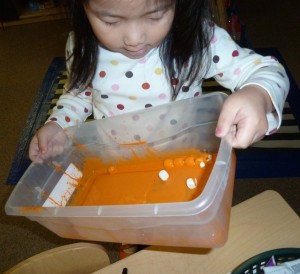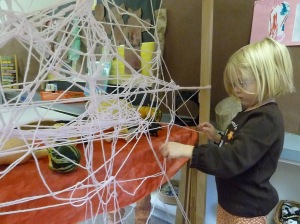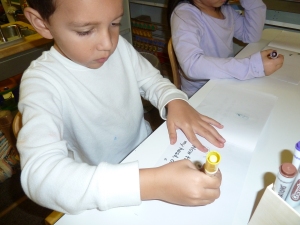 Our current math unit introduces and reinforces the concept of pattern creation and continuation. Luckily, Halloween provides us many opportunities to practice and play with these ideas. We were inspired while reading Six Creepy Sheep, by Judith Ross Enderle and Stephanie Gordon Tessler, and created some creepy decorations of our own. In the picture on the left, one of the students is preparing wooden beads in an orange paint bath. We also mixed up some lovely green, goblin beads. When they dried, we drew faces on them to give them a bit of character. Next, we strung them in an ABAB pattern on some skinny, wooden skewers. To keep the beads from falling off, the students used Model Magic to fashion a pumpkin and a round cap for each end of the stick. (Note: If either end pops off, simply add a bit of white glue, stick it back together, and let it sit over night to dry.) Finally, each child sorted through a large pile of wooden letter beads and found the blocks needed to make their own names. These were strung on ribbon and laced through the pumpkins so that the project could be hung from a door handle.
Our current math unit introduces and reinforces the concept of pattern creation and continuation. Luckily, Halloween provides us many opportunities to practice and play with these ideas. We were inspired while reading Six Creepy Sheep, by Judith Ross Enderle and Stephanie Gordon Tessler, and created some creepy decorations of our own. In the picture on the left, one of the students is preparing wooden beads in an orange paint bath. We also mixed up some lovely green, goblin beads. When they dried, we drew faces on them to give them a bit of character. Next, we strung them in an ABAB pattern on some skinny, wooden skewers. To keep the beads from falling off, the students used Model Magic to fashion a pumpkin and a round cap for each end of the stick. (Note: If either end pops off, simply add a bit of white glue, stick it back together, and let it sit over night to dry.) Finally, each child sorted through a large pile of wooden letter beads and found the blocks needed to make their own names. These were strung on ribbon and laced through the pumpkins so that the project could be hung from a door handle.
 Much earlier in the week, the children became very excited over some cobwebs we found outside. We decided that, for the upcoming holiday, a web would make a lovely addition inside our room, as well. I prepared the weaving area by making a large X with an additional center line out of yarn on our play awning. The children we then each given a turn with the roll of yarn and off they went! I’m actually quite impressed with how it turned out. They each took their time planning where they wished to place their string. The result is nicely spread out and surprisingly “webby”. On Friday, we made spiders out of pipe cleaners to adorn our creation. I’m interested in seeing if the spiders will become a popular plaything next week.
Much earlier in the week, the children became very excited over some cobwebs we found outside. We decided that, for the upcoming holiday, a web would make a lovely addition inside our room, as well. I prepared the weaving area by making a large X with an additional center line out of yarn on our play awning. The children we then each given a turn with the roll of yarn and off they went! I’m actually quite impressed with how it turned out. They each took their time planning where they wished to place their string. The result is nicely spread out and surprisingly “webby”. On Friday, we made spiders out of pipe cleaners to adorn our creation. I’m interested in seeing if the spiders will become a popular plaything next week.




